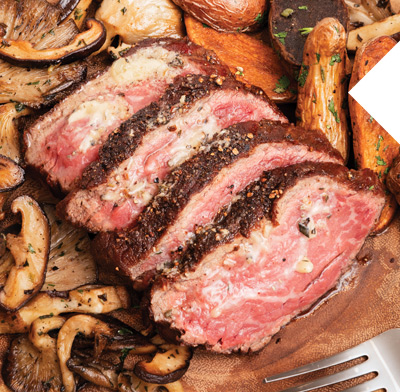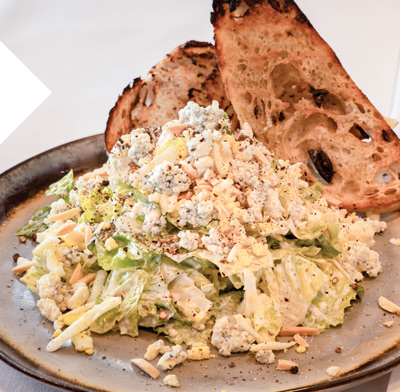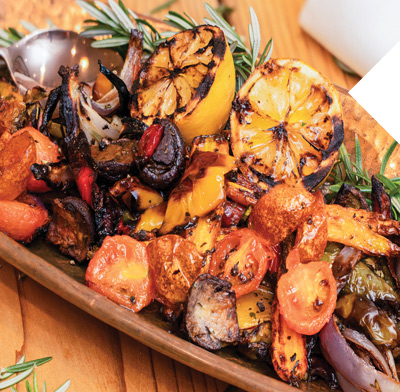Along with my passion for cooking, I also have a small family farm on San Juan Island and raise hogs. Home curing bacon, hams, and grinding gourmet sausage during the winter months is a hobby of mine and each year is a little better than the last. Last month, I transported three fat hogs to market and met with Ralf from Oak Harbor who raises purebred Wagyu beef on his ranch. His beef is amazing, and we quickly started sharing stories about our favorite cuts of beef. After a mouth-watering debate of all the great steaks we have tasted over the years, we both agreed that the Spinalis Dorsi or Prime Rib Cap Steak was up there as one the best steaks of all time. This month, I wanted to share three of my favorite recipes that create an unforgettable meal.
As a starter, Roche Harbor’s Maytag® blue cheese salad has been our most popular salad for more than 26 years, and it’s all because of the amazing blue cheese, always among the top 100 cheeses in the world. When I suggest the salad to new guests of the harbor, some tell me right away that they do not care for blue cheeses. After their first bite of this delicately ripened cheese, they are hooked. Our dressing recipe complements the blue cheese, and when the crisp romaine combines with the creaminess of the dressing, it is an experience hard to duplicate with any other blue cheese.
For the main course, it must be the prime ribeye cap steak, pan-seared to medium rare with Tuscan-styled steak butter and accompanied by oven roasted vegetables tossed in fresh lemon oil.
 |
Ribeye Cap SteakOf all the cuts of beef to choose from, the ribeye is the most popular in the world because of its rich beef flavor and tenderness. The cap of the ribeye is the single most delectable and flavorful steak available. Also known as the ribeye cap, deckle steak, calotte, or Spinalis Dorsi, it is highly prized by top chefs, beef aficionados, and butchers alike. The ribeye cap steak has the tenderness of a filet mignon, the rich marbling of a rib steak, and a mouthwatering flavor and texture all its own. This steak is the richest, butteriest, most tender, and beefiest steak you will ever taste and intended to be eaten slowly with a big, voluptuous cabernet sauvignon. Like the ribeye, the cap steak is best when cooked quickly over high heat in a seasoned cast iron skillet or cast iron grill. Serves 6
Directions: Heat a 10-inch cast iron skillet over medium high heat. Season steaks with salt and pepper. Add butter to skillet and after the butter has melted, place steak in skillet and allow to brown on one side for 3 to 4 minutes. Turn steak over and sear for an additional 3 to 4 minutes or until the steak reaches an internal temperature of 115˚ (rare), 125˚ (medium rare), 130˚ (medium), 140˚ (medium well), or 150˚ (well). Remove from pan cover with an aluminum foil tent and allow to rest for 15 to 20 minutes. After the steaks have rested, squeeze a small amount of lemon juice over each steak, followed by a tablespoon of steak butter. The butter is intended to melt and baste the steak. Serve immediately. Chef’s Note: Resting steaks allow the meat to relax and finish, but more importantly prevents releasing all the flavorful juices when steak is cut. Tuscan Steak ButterSteak butter can be made ahead of time and rolled in parchment paper into a 1” diameter log, then frozen. When needed, pull the frozen butter log from the freezer and slice into ½” thick coins, place a butter coin on each steak after cooking. As the butter melts, it combines with the steak juices, creating a rich and flavorful sauce.
Directions:Remove 2 sticks of unsalted butter from the refrigerator and set out for 2 hours to soften. In a small bowl, combine softened butter and remaining ingredients. Blend with a wooden spoon to incorporate all the ingredients. Tear off a 1 inch length of parchment paper and place the butter compound at one end. Work the butter into a log shape that has a 1½ inch diameter, then roll the paper tightly around the butter, forming a 1 inch diameter log. Wrap log in plastic food wrap and freeze until needed. |
Maytag® Blue Cheese SaladMakes 4 Salads
Directions: Remove the outer dark green leaves from the romaine head until the light green leaves are exposed. Remove the bitter dark tip of the romaine heart, then slice in half lengthwise. Slice the romaine by placing the heart-cut side down on the cutting board and running your knife lengthwise from the stem to the tip, creating three 1 ½ inch strips, then slice the strips into 1 ½ inch by 1 ½ inch pieces. Soak the chopped romaine in a bowl of ice-cold water for 20 minutes. This will allow the romaine to absorb the moisture resulting in a crisp bite. Drain the water and dry the romaine on a towel or in a lettuce spinner. Place the lettuce in the refrigerator with a damp towel covering the lettuce until you are ready to serve the salad. Boil the eggs by placing them in a saucepan with cold water over medium high heat. When the water begins to boil, cover the saucepan with a lid and remove from heat. Allow the eggs to slowly cook for 18 minutes. Place the saucepan in the sink and pour cold water over the eggs until they are cool, about 15 minutes. Crack and peel the eggs in the water. Using a fine cheese grater, grate the eggs into a bowl, then refrigerate. Preheat your oven to 350 degrees, then place the slivered almonds on a cookie sheet and bake until light golden brown stirring the almonds half way through. Remove the toasted almonds and allow to cool. Place the wedge of blue cheese in the freezer for 15 to 20 minutes. Then slice into ¼” slices. Break up the slices by hand into a fine crumble, then refrigerate. When ready to serve, pour the dressing over the chilled romaine and toss by hand, being careful not to bruise the romaine. After the romaine is thoroughly coated with the blue cheese dressing, place equal amounts of dressed romaine on 4 chilled plates and build the romaine into a volcano shape. Garnish each salad started with the equal amounts of chopped egg, followed by toasted almonds, and finally with crumbled blue cheese. Allow the egg, almonds, and blue cheese to cascade down the mound of dressed romaine. Serve immediately with fresh cracked pepper and a chilled salad fork. Maytag® Blue Cheese Dressing
Directions:Place the blue cheese in the freezer for 15 to 20 minutes, then slice into ¼ inch slices and break apart by hand into 1/2 inch pieces. Freezing the creamy cheese makes it easier to slice and crumble. In a medium-sized bowl, add garlic, dry mustard, black pepper, onion powder, and white pepper and combine with a wire whip. Add red wine vinegar, Worcestershire, and tobacco; mix with wire whip until thoroughly combined. Add sour cream, mayonnaise, and buttermilk and mix for two minutes, creating a creamy mixture. Add the blue cheese crumbles and gently fold into the creamy mixture, creating a chunky blue cheese dressing. Transfer to a non-reactive dish and refrigerate overnight to allow flavors to blend. |
 |
 |
Lemon Roasted Summer VegetablesRoasted or grilled vegetables are my favorite style of cooking vegetables, and whether it is a combination of root vegetables and beets or baby squashes and onions, they are always impressive. The trick to making these vegetables taste even more amazing than they look is to allow your oven or grill to do the work while the cook remains patient but attentive. Allow the vegetables to brown and char, then turn over and brown and char again. The crunchy, burnt edges of the peppers are my favorite and can be eaten cold on a bruschetta. Serves 8 as a side dish
½ cup Parmesan cheese, grated fine 2 Tablespoons fresh basil, torn into ¼ inch pieces Directions: Preheat oven to 400˚. Use the convection feature if your oven is equipped. Cut vegetables as directed. When cutting the onion wedges, trim the root ends slightly but retain the root core, then slice the onion in half through the middle of core. Repeat the same procedure by cutting the half into a quarter, sliced through the center of the root core. This will keep the onion layers attached to the core in one piece. The goal is to create as many thin, flat surfaces as possible to allow the heat to bring the natural sugars of the vegetables to the surface and caramelize or brown. In a large bowl, add the peppers, zucchini, mushrooms, onion, and carrots. In a small bowl, combine olive oil, lemon juice, garlic, rosemary, salt, and pepper and stir to combine. Pour the olive oil and lemon mixture over the vegetables and toss to coat vegetables completely. Using a large baking sheet, arrange oiled vegetables in a single layer across the baking sheet. Place in oven and roast for 10 minutes, then turn vegetables. Add cherry tomatoes and continue roasting vegetables until tips and edges of the vegetables begin to brown and char, about 5 to 6 minutes. Turn vegetables over again, until vegetables are browned and caramelized. Remove from oven and place roasted vegetables on a serving platter. Squeeze half of a fresh lemon over vegetables followed by Parmesan and fresh basil. Chef’s Note: Don’t be afraid of visible black charring on the tips and outer edges. This charring or caramelization of the vegetable sugars adds flavor and makes an impressive presentation. |